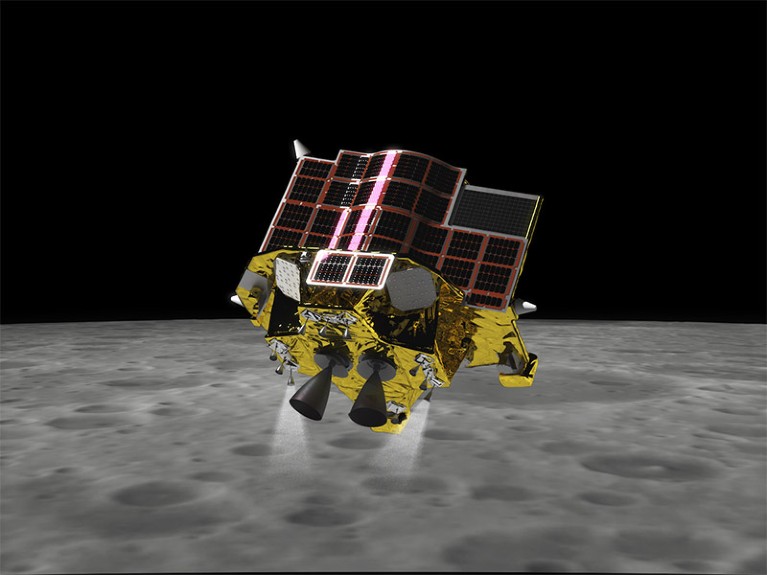
Artist’s impression of the SLIM spacecraft coming in for landing on the Moon.Credit: JAXA
Japan has become the fifth country in the world to soft-land a spacecraft on the Moon, using precision technology that allowed it to touch down closer to its target landing site than any mission has before. However the spacecraft might have survived on the lunar surface for just a few hours due to power failure.
Telemetry showed that the Smart Lander for Investigating Moon, or SLIM, touched down in its target area near Shioli crater, south of the lunar equator early Saturday morning, four months after lifting off from the Tanegashima Space Centre, off the south coast of Japan.
“SLIM has made it to the Moon’s surface. It has been communicating with our ground station and responding to commands from Earth accurately,” Hitoshi Kuninaka, vice president of Kanegawa-based Japan Aerospace Exploration Agency (JAXA), told a press conference after the landing was completed.
“However, it seems that the solar cells are not generating electricity at this point, and the spacecraft is operating solely on its battery,” Kuninaka said. “The battery will last several more hours — those hours will be the remaining life of SLIM.” He said the agency would continue monitoring the lander, as there was still a chance the panels would start working.
The successful landing comes around two weeks after a commercial US spacecraft launched for the Moon, only to discover a propellant problem that means it won’t be able to land as planned. It’s also almost a year since a Japanese commercial lander crashed into the Moon in failure; Moon landings are notoriously difficult to pull off and a commercial company has yet to do so.
Namrata Goswami, a space policy expert at Arizona State University in the United States says the successful landing is “a big win for Asia”. Only China, India, and Japan have put a spacecraft on the Moon in the past decade. India successfully landed in August 2023.
Innovative technology
Table of Contents
According to Kuninaka, SLIM has very likely achieved its primary goal — to land on the Moon with an unprecedented accuracy of 100 metres, which is a big leap from previous ranges of a few to dozens of kilometres. SLIM carried vision-based navigation technology, which was intended to image the surface as it flew over the Moon, and locate itself quickly by matching the images with onboard maps.
It remains unclear if the car-sized, 200-kilogram spacecraft actually touched down in the planned, two-step manner with its five legs. Unlike previous Moon landers, which used four legs to simultaneously reach a relatively flat area, SLIM was designed to hit a 15-degree slope outside Shioli crater first with one leg at the back, and then tip forward to stabilize on the four front legs.
Observers suggest that SLIM might have rolled during its touch-down, preventing its solar cells from facing the Sun. Kuninaka said not enough data were available to establish the probe’s posture or orientation. However, if some sunlight is able to reach the solar cells there is a chance that SLIM could come back to life.
An additional two small robots were intended to eject from SLIM before touch-down according to Kuninaka. They were supposed to take images of the lander and return them to Earth, but at this stage it’s unclear whether they deployed.
If SLIM can come back to life, scientists plan to use a specialized camera — the only scientific instrument onboard — to look for a mineral called olivine in the Moon’s mantle. “If we can detect the olivine’s components and compare it with its counterpart on Earth, it may offer new evidence to support the theory that the Moon was part of Earth long time ago,” says Shinichiro Sakai, the mission’s project manager at JAXA.
The camera would also help confirm the origin of the Apollo 16 Moon samples. The landing site is about 250 kilometres east of Apollo 16’s 1972 landing site and to the west of an ancient lunar sea called Mare Nectaris. “In Apollo 16 samples, we found exotic basalts which were most likely ejected from Mare Nectaris,” says Clive Neal, a planetary geologist at the University of Notre Dame, Indiana. By helping confirm the source, SLIM could tell scientists a lot about impact dynamics and the chemistry of the ancient sea. “It would show that smaller missions can still be very productive and do important science,” Neal says.
Moon rush
Sakai and his team hoped that SLIM’s pinpoint landing technology would give Japan a head-start in the US-led Artemis Program, which aims to return humans to the Moon in three years’ time. “This technology can be applied to many missions and may constitute a Japanese contribution in international cooperation,” says Sakai.
While SLIM makes Asia shine in the new Moon race, it might also intensify the competition between spacefaring nations in the region, Goswami says. Now that both India and Japan have mastered technologies to soft land on the Moon, their planned joint mission, known as the Lunar Polar Exploration Mission or LUPEX, could rival China’s Chang’e-7 mission which also aims to land in the lunar south pole region in 2026 to look for frozen water.
The Moon is experiencing an uptick in visitors in recent months. SLIM was the second Moon landing attempt this year, after the ill-fated US Peregrine spacecraft. Next month, the US company Intuitive Machines will continue to challenge to become the first commercial company to land a spacecraft on the Moon. Later this year China will launch its Chang’e-6 mission to return samples from the far side of the Moon.
